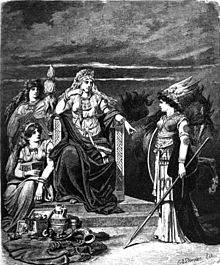Fensalir

InNorse mythology,Fensalir(Old Norse"FenHalls "[1]) is a location where the goddessFriggdwells. Fensalir is attested in thePoetic Edda,compiled in the 13th century from earlier traditional sources, and theProse Edda,written in the 13th century bySnorri Sturluson.Scholars have proposed theories about the implications of the location, including that the location may have some connection toreligious practices involving springs, bogs, or swampsinNorse paganism,and that it may be connected to the goddessSága's watery locationSökkvabekkr.
Attestations[edit]

In thePoetic EddapoemVöluspá,Frigg is described as weeping over her sonBaldr's death in Fensalir. This stanza is absent in theHauksbókmanuscript of the poem.[2]The portion of the stanza mentioning Fensalir foretells that vengeance will come for the death of Baldr and that:
In chapter 35 of theProse EddabookGylfaginning,HightellsGangleri(described as kingGylfiin disguise) that Frigg is the highest among theásynjuror Aesir, and that "she has a dwelling called Fensalir and it is very splendid."[4]In chapter 49, High says that whenLokiwitnessed that Baldr had gained invincibility due to the oath all things took not to harm him, Loki went to Fensalir appearing as a woman. In his disguise, Loki there asked Frigg why Baldr was not harmed by the objects. Frigg revealed that it is due to the oath they have taken. The disguised Loki asks if nothing can hurt Baldr, and Frigg reveals that onlymistletoecan, for it seemed to her too young to demand an oath from. After this, Loki immediately disappears, and subsequently engineers the death of Baldr with a mistletoe projectile.[5]
In theProse EddabookSkáldskaparmál,Fensalir receives a third and final mention. In chapter 19, ways to refer to Frigg are provided, including that Frigg may be referred to as "queen ofÆsirand Asyniur, ofFullaandfalconform and Fensalir. "[6]
Theories[edit]
In 1882, the German scholar Anton Edzardi proposed that Fensalir may point to religious practices involvingsprings.[7]John Lindowcomments that "I have no idea why Frigg should live in aboggyplace, despite the old argument that there is an association with a cult situated at a spring. "[2]Rudolf Simekcomments that Edzardi's theory "must remain unanswered."[8]In addition, Edzardi theorized a connection between Fensalir and a belief in folklore that particular swamps act as an entrance to the realm ofHolda,whom he connects with Frigg.[9]
In a 19th-century work,Paul Henri Malletand Walter Scott write that the "fen" element ofFensalir"may also be made to sig[nify] the watery deep, or thesea."[10]Thisetymologyhas resulted in theories that the nameFensalirmay mean "Sea Halls" rather than "Fen Halls." In his 19th-century translation of thePoetic Edda,Henry Adams Bellowscomments that "some scholars have regarded [Frigg] as a solar myth, calling her thesun-goddess,and pointing out that her home inFensalir( "the sea-halls" ) symbolizes the daily setting of the sun beneath the ocean horizon. "[11]
John Lindowsays that due to similarity between the goddessSága'sSökkvabekkrand Fensalir, the open drinking between Sága and Odin, and the potential etymological basis for Sága being a seeress "have led most scholars to understand Sága as another name for Frigg."[12]Stephan Grundystates thatSágaandSökkvabekkrmay be by-forms ofFriggandFensalirused for the purpose of composingalliterative verse.[13]
Britt-Mari Näsström theorizes that "Frigg's role as a fertility goddess is revealed in the name of her abode, Fensalir [...]", that Frigg is the same as Sága, and that both the namesFensalirandSökkvabekkr"imply a goddes [sic] living in the water and recall the fertility goddessNerthus."[14]
Notes[edit]
- ^Orchard (1997:43).
- ^abLindow (2001:114).
- ^Dronke (1997:16).
- ^Faulkes (1995:29).
- ^Faulkes (1995:48).
- ^Faulkes (1995:86).
- ^Edzardi (1882:330–339) referenced in Lindow (2001:115).
- ^Simek (2007:81).
- ^Gildersleeve (1883:105).
- ^Mallet, Scott (1847:550).
- ^Bellows (2004:15).
- ^Lindow (2001:265).
- ^Grundy (1999:62).
- ^Näsström (1996:88).
References[edit]
- Bellows, Henry Adams(Trans.) (2004).The Poetic Edda: The Mythological Poems.Courier Dover Publications.ISBN0-486-43710-8
- (in German)Edzardi, Anton (1882). "Fensalir und Vegtamskvida 12, 5ff." inGermania27, edited by Franz Pfeiffer, pp. 330–339. Wien: Verlag von Carl Gerold's Sohn.
- Faulkes, Anthony (Trans.) (1995).Edda.Everyman.ISBN0-460-87616-3
- Grundy, Stephan(1999). "Freyja and Frigg" as collected in Billington, Sandra and Green, Miranda.The Concept of the Goddess.Routledge.ISBN0-415-19789-9
- Dronke, Ursula(Trans.) (1997).The Poetic Edda: Volume II: Mythological Poems.Oxford University Press.ISBN0-19-811181-9
- Lindow, John(2001).Norse Mythology: A Guide to the Gods, Heroes, Rituals, and Beliefs.Oxford University Press.ISBN0-19-515382-0
- Gildersleeve, L. Basil(ed.) (1883).American Journal of Philology.Vol. IV. New York and London: Macmillan & Co.
- Mallet, Paul Henri.Scott, Walter (1847) translated byThomas Percy.Northern Antiquities: Or, An Historical Account of the Manners, Customs, Religion and Laws, Maritime Expeditions and Discoveries, Language and Literature of the Ancient Scandinavians.H. G. Bohn.
- Näsström, Britt-Mari (1996). "Freyja and Frigg - two aspects of the Great Goddess" as presented inShamanism and Northern Ecology: Papers presented at the Regional Conference on Circumpolar and Northern Religion, Helsinki, May 1990.Walter de Gruyter.ISBN3-11-014186-8
- Orchard, Andy (1997).Dictionary of Norse Myth and Legend.Cassell.ISBN0-304-34520-2
- Simek, Rudolf(2007) translated by Angela Hall.Dictionary of Northern Mythology.D.S. BrewerISBN0-85991-513-1
External links[edit]
 Media related toFensalirat Wikimedia Commons
Media related toFensalirat Wikimedia Commons
